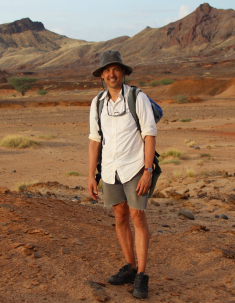You Asked: What’s It Going to Take to Adapt to Climate Change?
Paleoecologist Kevin Uno explains how humans have been adapting to changes in climate for thousands of years, and how we need to adapt now to protect our species’ future.
“You Asked” is a series where Earth Institute experts tackle reader questions on science and sustainability. The following questions were submitted to paleoecologist Kevin Uno following his talk, “Climate Control: How We Broke the Planet’s Thermostat and What to Do Next.” In the talk, filmed as a part of the Lamont Doherty Earth Observatory’s 2020 Open House at Home, Uno explains how humans have adapted to changes in climate for thousands of years, and how we need to adapt now to protect our species’ future.
What role do you think the federal government should take in ensuring humanity makes the necessary changes to its lifestyle? Do you think climate scientists should play a role in our government? And if so, what?
Because climate change is such a far-reaching problem, it’s very hard for us to solve it as individuals, whereas there is a huge potential role for governments to help. There are many examples of things that a government does for its citizens to help us organize collectively and establish sets of rules. Speed limits are one such example. By giving people a set of guidelines to ensure that their behavior is safe when behind the wheel, drivers are reminded to be conscious of pedestrians, bikers, and other drivers. Climate change has become extremely politicized, particularly the last few decades; however, governance remains an effective way for us to organize to tackle a problem at a global level. This can go beyond the federal government in the United States coordinating its own citizens, like when national governments work together to establish guidelines for shared goals. International collaboration to this degree led to the Kyoto Protocol in 1997 and the Paris Agreement in 2015. Scientists also play a role in our government, serving as advisers on many different levels. In the same way that epidemiologists provide information about how to deal with the COVID-19 pandemic, climate scientists provide information about past conditions and projections of the future so that lawmakers can design effective policy. It is important to recognize and value what scientists can contribute to making our lives safer.
Conservation is frequently overlooked as a way to make sure we continue to survive. Shouldn’t that be number one on the list of what we can all do to make a difference?
Conservation is incredibly important to solving the climate change problem. We can each do our part to conserve resources. We can try to consume less. We can try to travel less — something we’re all doing really well this past year. Conservation plays a huge role in how we reduce our fossil fuel emissions and really address climate change. However, there is also room for adapting and changing how we do things, such as building more efficient ways of using energy or entirely new forms of energy altogether. The solution to climate change isn’t limited to a singular action. There are so many things we can do, as individuals and as a society, that will be a part of the solution.
How much do you attribute the quality of child care to the survival of our species through changes in climate in the early days of our species?

The way that early humans cared for their young had an incredibly big impact on their survival. As our ancestors evolved from early hominins into Homo sapiens, we got taller and thinner. We developed the ability to walk upright, greatly changing the shape of the pelvis such that the birth canal for human females became incredibly small. The tradeoff was giving birth at a more altricial state, meaning newborn humans are completely helpless. However, early humans also developed very strong social structures and complex group interactions.
Most likely, co-parenting or group child rearing practices were well established, providing additional resources to care for and raise children. Multiple hands and eyes on kids would have provided a buffer in challenging situations, such as those related to climate or environmental change. This phenomenon would have had an impact not only over the short span of those children’s early years, but through generations. Even after a female’s fertility ends, she can devote the energy previously spent reproducing and having children, to taking care of the children in her lineage or group—this is known as the grandmother hypothesis. In that sense, she provides extra support for the next generation, so that the mothers who are having babies can focus on that rather than other things like preparing food. These child-rearing practices certainly would have contributed to the group’s resilience, enabling them to better survive changes in climate and other shocks.
